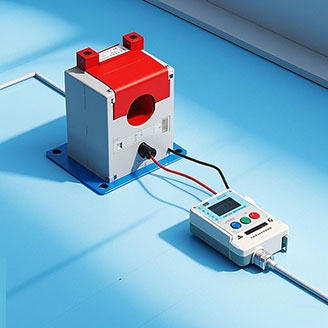The residual current transformer (also known as the residual current protector) is a crucial device used for accurately detecting and preventing leakage faults in power systems. It has a wide range of applications, covering DC systems, high - voltage DC transmission systems, and distribution systems. In actual operation, once a leakage fault is detected, it can quickly cut off the faulty circuit, effectively preventing the occurrence of electrical accidents and safeguarding the safe and stable operation of the power system.
Basis of the Working Principle
The operating mechanism of the residual current transformer is essentially based on the principle of current balance. Under normal circumstances, the vector sum of the currents in each phase of the circuit is zero, maintaining a balanced state. However, when a leakage fault occurs, part of the current will flow into the ground or other media, disrupting the original current balance and generating a residual current. The residual current transformer precisely identifies the presence of a leakage fault by sensitively detecting this residual current in the circuit and determining whether the current is balanced.
Structural Composition and Functions
The residual current transformer mainly consists of two major components, the transformer and the relay, which work in coordination.
- Transformer: As a sensing element for residual current, the transformer uses the current mutual - induction effect to accurately convert the residual current generated in the circuit into a corresponding voltage signal. Its structure typically includes two windings. One winding is connected in series in the main circuit, carrying the main - circuit current, while the other winding is specifically designed to sense the residual current in the circuit. According to the law of electromagnetic induction, when the current in one winding changes, the other winding will, due to mutual - induction, induce a corresponding voltage change, thus effectively capturing and converting the residual current.
- Relay: It is responsible for in - depth processing, analysis, and judgment of the voltage signal output by the transformer. When the voltage signal corresponding to the residual current detected in the circuit exceeds a pre - set threshold, the relay will immediately activate the cut - off device, quickly cutting off the faulty circuit to prevent the further expansion of the accident. In addition, the relay is also equipped with an alarm function. Once it is triggered, it will promptly send an alarm signal to notify relevant personnel to handle the fault as soon as possible.
Specific Working Process

- Residual Current Detection: During the operation of the power system, once a leakage fault occurs in the circuit, the leakage current will flow into the ground or other media, causing the total circuit current to become unbalanced. At this time, the residual current transformer responds rapidly. Through the mutual - induction effect, it converts the leakage current into a voltage signal. The two windings of the transformer, one changes with the main - circuit current, and the other accurately senses the residual current and converts it into a voltage signal that can be processed subsequently.
- Signal Processing: The voltage signal output by the residual current protector first enters the signal - processing circuit. This circuit filters the signal to remove noise interference, ensuring the purity of the signal. At the same time, it amplifies the signal to enhance its strength, guaranteeing the stability and reliability of the signal during transmission and subsequent processing. After careful processing, the signal is transmitted to the relay, providing accurate data support for the next - step judgment and control.
- Fault Judgment and Control: After receiving the signal transmitted from the signal - processing circuit, the relay precisely compares it with the pre - set threshold to determine whether there is a leakage fault. Once the signal output by the transformer exceeds the set value, the relay immediately triggers the cut - off device, rapidly cutting off the faulty circuit to prevent the aggravation of the electrical accident. At the same time, the relay will simultaneously send an alarm signal to remind relevant personnel to intervene in a timely manner, troubleshoot, and resolve the fault.
Key Points for Use
When using the residual current transformer, it is necessary to fully consider the specific requirements of the power system and carry out reasonable selection and precise adjustment. Power systems with different current ratings and sensitivity requirements need to be matched with appropriate transformer models, and reasonable thresholds should be set according to the actual situation to ensure the accuracy and reliability of fault detection. In addition, during the installation and use of the equipment, relevant safety operation procedures must be strictly followed to ensure the normal and stable operation of the equipment and effectively exert its leakage protection function.
In conclusion, the residual current transformer ingeniously converts the leakage current into a voltage signal through the mutual - induction effect, and then through elaborate signal processing and precise judgment, it achieves efficient detection and reliable protection of leakage faults. In the power system, it plays an indispensable role, greatly enhancing the safety and reliability of the power system and providing a solid guarantee for people's production and daily life. With SISCO's professional testing equipment and comprehensive services, the performance testing and optimization of residual current transformers become more convenient and accurate, further ensuring the safety and stability of power systems.

